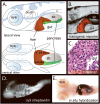New school in liver development: lessons from zebrafish
- PMID: 19693947
- PMCID: PMC3093159
- DOI: 10.1002/hep.23157
New school in liver development: lessons from zebrafish
Abstract
There is significant overlap in the genes and pathways that control liver development and those that regulate liver regeneration, hepatic progenitor cell expansion, response to injury, and cancer. Additionally, defects in liver development may underlie some congenital and perinatal liver diseases. Thus, studying hepatogenesis is important for understanding not only how the liver forms, but also how it functions. Elegant work in mice has uncovered a host of transcription factors and signaling molecules that govern the early steps of hepatic specification; however, the inherent difficulty of studying embryogenesis in utero has driven developmental biologists to seek new systems. The rapidly developing vertebrate zebrafish is a favorite model for embryology. The power of forward genetic screens combined with live real-time imaging of development in transparent zebrafish embryos has highlighted conserved processes essential for hepatogenesis and has uncovered some exciting new players. This review presents the advantages of zebrafish for studying liver development, underscoring how studies in zebrafish and mice complement each other. In addition to their value for studying development, zebrafish models of hepatic and biliary diseases are expanding, and using these small, inexpensive embryos for drug screening has become de rigueur. Zebrafish provide a shared platform for developmental biology and translational research, offering innovative methods for studying liver development and disease. The story of hepatogenesis has something for everyone. It involves transcriptional regulation, cell-cell interaction, signaling pathways, control of cell proliferation and apoptosis, plus morphogenic processes that sculpt vasculature, parenchymal cells, and mesenchyme to form the multifaceted liver. Decades of research on liver development in mice and other vertebrates offer valuable lessons in how the multipotent endoderm is programmed to form a functional liver. Of equal importance are insights that have illuminated the mechanisms by which hepatic progenitors are activated in a damaged liver, how the adult liver regenerates, and, possibly, the basis for engineering liver cells in vitro for cell transplantation to sustain patients with liver failure. Moreover, processes that are key to liver development are often co-opted during pathogenesis. Therefore, reviewing hepatogenesis is informative for both basic and translational researchers. In this review, we bring to light the many advantages offered by the tropical freshwater vertebrate zebrafish (Danio rerio) in studying hepatogenesis. By comparing zebrafish and mice, we highlight how work in each system complements the other and emphasize novel paradigms that have been uncovered using zebrafish. Finally, we highlight exciting efforts using zebrafish to model hepatobiliary diseases.
Figures


References
-
- Hogan BM, Verkade H, Lieschke GJ, Heath JK. Manipulation of gene expression during zebrafish embryonic development using transient approaches. Methods Mol Biol. 2008;469:273–300. - PubMed
Publication types
MeSH terms
Grants and funding
LinkOut - more resources
Full Text Sources
